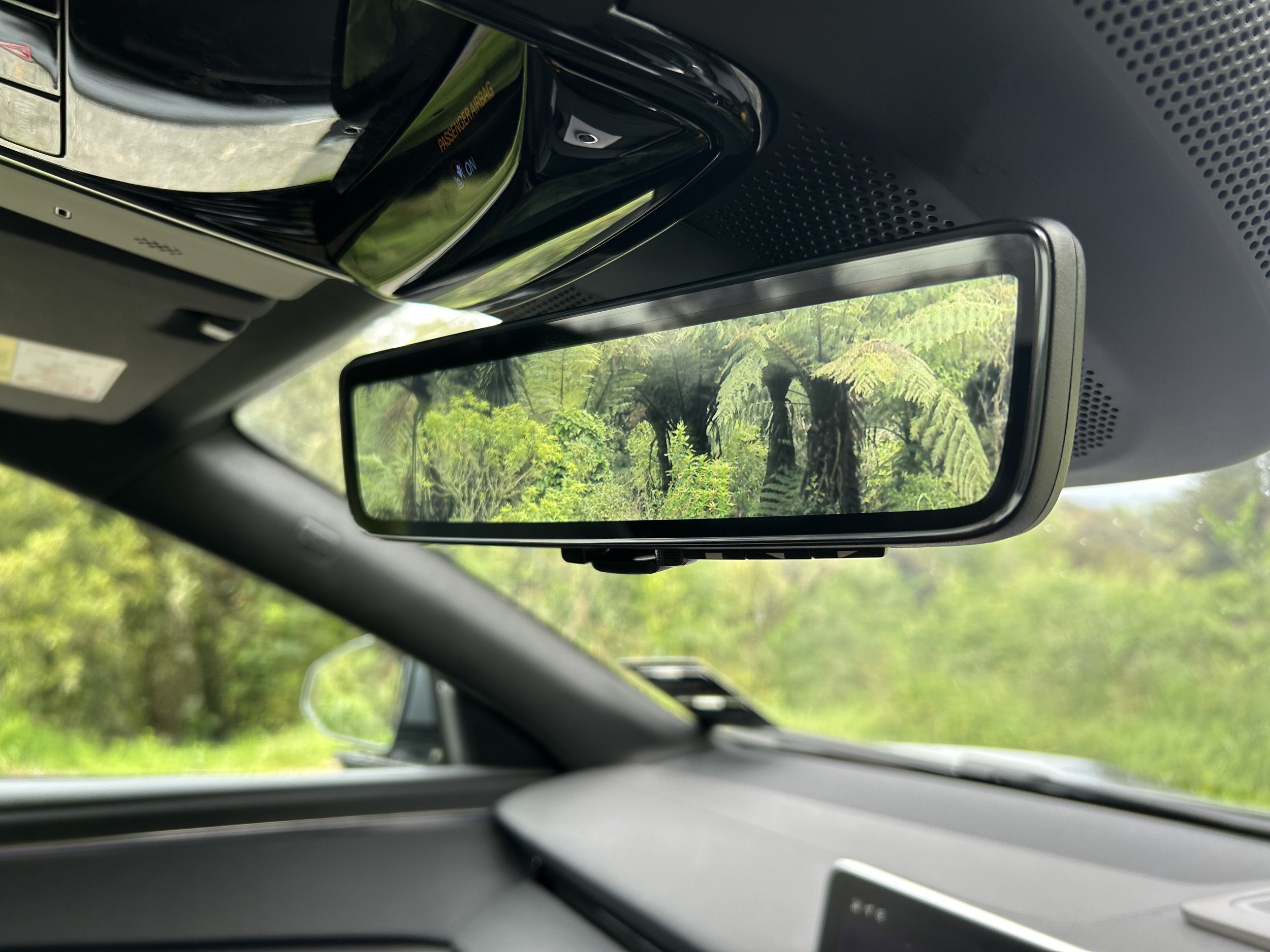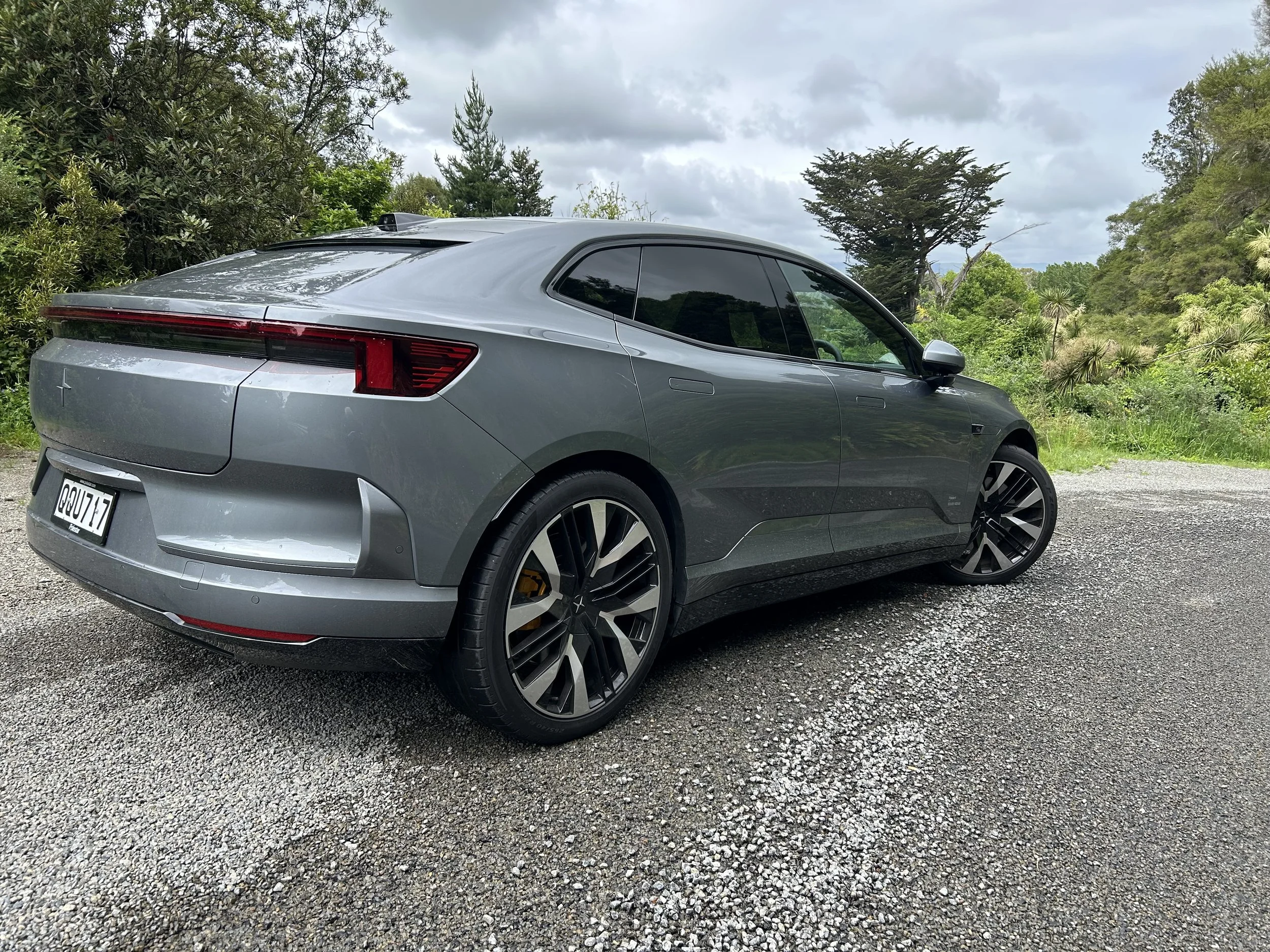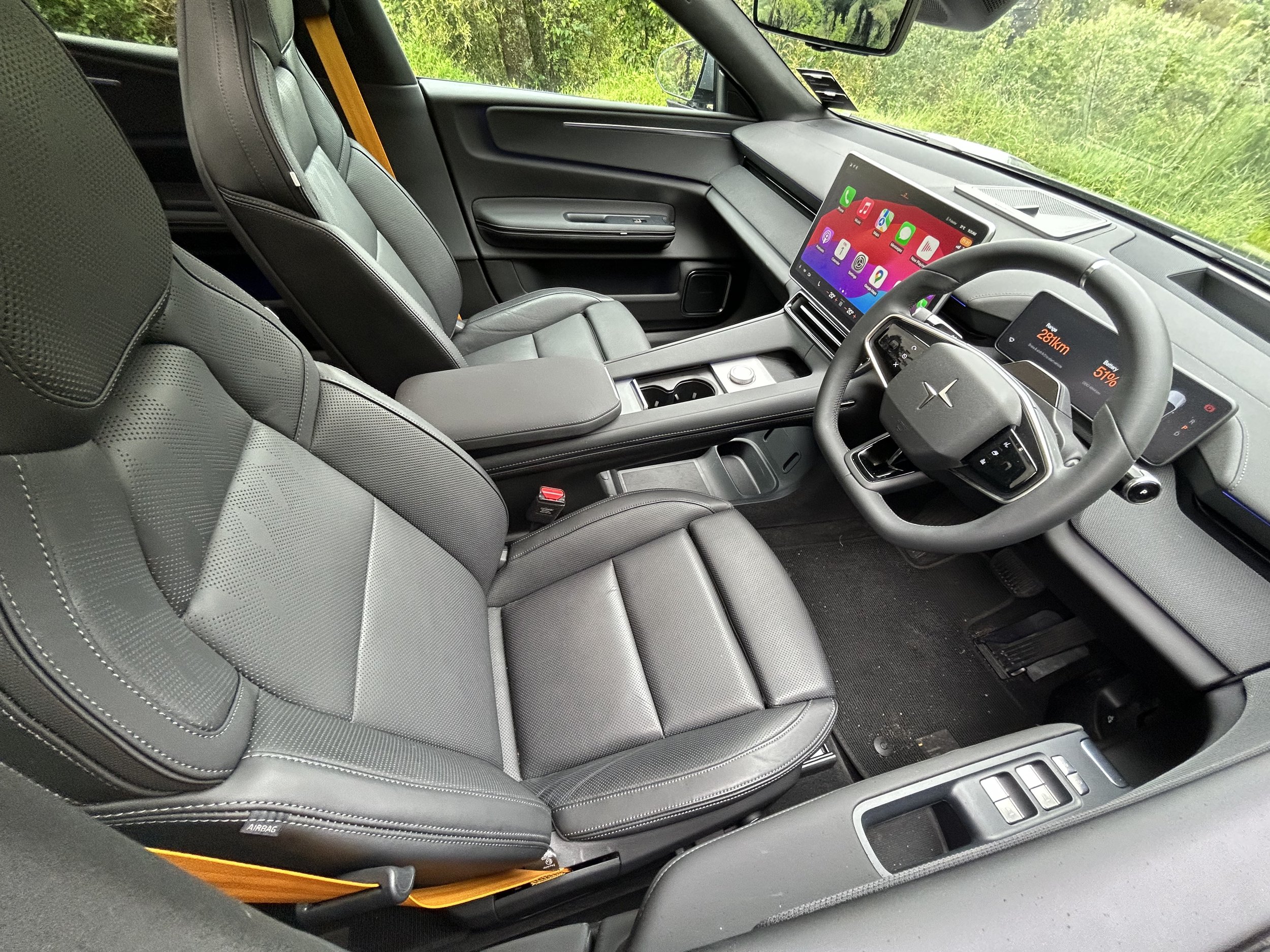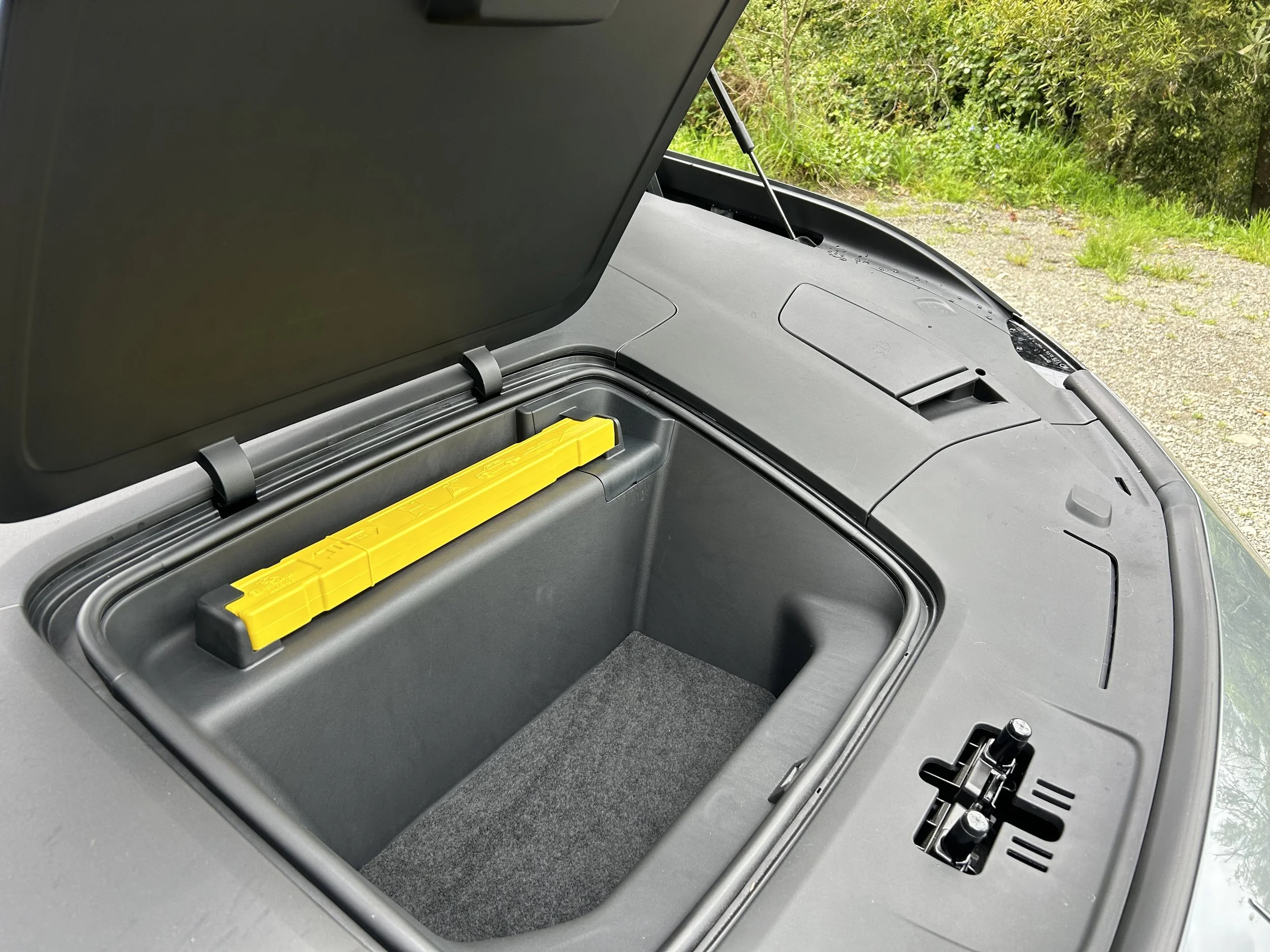Polestar 4 roadtest review: No looking back
/Undeniably premium in its presentation, deliberately avant-garde in its styling and packaging … it’s a coupe-style SUV done different.
How much? $144,990 (as tested).
Powertrain: Dual electric motor, 100kWh lithium ion battery, single speed. Maximum combined power 400kW, maximum combined torque 686Nm; all-wheel-drive.
Dimensions: Length, 4839mm; width, 2008mm; height, 1534mm.
We like: Inviting and superbly-appointed interior; genuinely spacious rear; impressive drivetrain; stand-out refinement and styling.
Not so much: Softest ride setting would benefit from more compliance on coarse chip; a performance-lift shortcut button would be appreciated.
‘WHAT difference does it make’ , ‘what benefit does it bring’? Whenever a car does something truly different, those questions are inevitable.
Using camera views to replace traditional mirrors is a thing. We’ve had door-mounted cameras feeding screens in the cabin. Now something different again: A camera pointing from the back of the car, feeding its view to a 8.9-inch display within a traditional rear view mirror housing.
Better than a traditional mirror? Fifty-fifty on that. The feed has no lag whatsoever and in daylight hours is sharp as; at night a bit less so. Headlight glare is addressed reasonably well, but there’s a weird ghosting effect by which the (invisible by day) rear seats reveal. That’s due to a conventional mirror being underneath the digital overlay, there so a driver can keep an eye on rear occupants if they desire to. Makes sense. But weird.
Also, this set-up is clever-as in offering a 121-degree field of view and even a panning feature when you indicate, the usual absence of depth of field makes it hard to judge the closeness of objects behind. Even though the lens is tucked away within the tail, and looks to be protected from poor weather, might it nonetheless still risk exposure to road grime?
But anyway. The reason for having a camera display is obvious when you walk to the back of what by now you might well have guessed is the Polestar 4 is. the single most unusual thing about this car is … there’s no rear window. All part of the strong design identity. But just a gimmick, or a masterclass in thinking outside the box?
Polestar is definitely chasing buyers looking for something different in appearance: The ‘Four’ isn’t as gorgeous as the Precept styling study it spawned from, yet it’s definitely an attention-getter.
Fundamentally, the design lines also fulfil a functional aspect. Though it’s not quite the most aero choice in the class, closing in the rear with a solid body-coloured panel that leads down to a full-width light bar is just as useful for energy-saving gain as the flush door handles, closed in snub nose and a rakish windscreen.
Another plus from it leaving nothing behind is that it helps deliver on designer desire to make this car a better living space for all.
Forgoing something we’ve accepted to be as commonplace in any car as a steering wheel allows Polestar to deliver a semblance of sleekness with more spaciousness than other low-slung, similarly-silhouetted products avail.
So, as much as not having a rear window feels odd - for the first day or so, I’d catch myself pointlessly checking over my shoulder - brand exterior designer Nahum Escobedo is right in arguing this car has “a lounging, club-like space that feels both private and limousine-worthy.”
I’m tall. When I had the driver’s seat set just right, I still had lots of lounging room behind and felt genuinely comfortable, regardless that I did think it would better still if there was space to slide my feet under the seat in front.
As good as it is to sit back and luxuriate, you’re ultimately here for the driving experience and, in respect to that, the strongest flavour arrives with what’s on test.
With a 3.8 second 0-100kmh acceleration, the The Long Range Dual Motor is the fastest Polestar up to this point and with 400kW/686Nm is well-muscled.
It’s not just about pace; the optimal 590 kilometres’ range on the WLTP scale is strong for its kind and 30kms’ short of the most parsimonious variant, a single motor version with half the output.
As is always the case, you cannot really look to those ultimate ranges as being easily-achieved expectations. Polestar also quotes an efficiency between 18.7 and 21.7 kilowatt-hours per 100 kilometres. In my time with the car, my energy use sat around 23kWh/100km, so not within the sweet spot. Still, what I would say is that the distance to empty calculation did seem very accurate.
Both models come equipped with a 100kWh battery, of which 94kWh is useable. The battery can accept charge rates of 200kW from a DC fast charger - which meant it facilitated relatively little dwell time at the 300kW station near me - and, when the car has the optional Plus pack, up to 22kW on an AC connection.
So, it’s technically well equipped - and extremely well-kitted, too, when outfitted as this one is, with Plus and Performance Packs that lift the base price by $15k. Expensive? Maybe, but I cannot see how you’d get by without at least the first.
Premium audio, power adjust rear seats, best leather trim, a powered boot, 22-inch alloys with 265/40 rubber, Brembo brakes and Polestar chassis tuning are gloat-worthy. The Swedish gold details for the brakes, seat belts and valve caps? Maybe not so much.
Given that goes without a back window, it might seem weird to say the most overt single flamboyance is a huge piece of glazing. Nonetheless the full length sun roof, extending all the way back to behind the rear seat headrests, is a wholly arresting element. I’m not usually a fan, but my usual issue - that glass-tops can be a real sun trap in summer - does seem to be sorted here by an electro-chromatic feature to switch between opaque or transparent. Also, I’ll concede the see-through roof delivers wonderful amplification of the sense of space and it being spesh. During the day, the cabin feels open and airy; at night, it becomes a different cocoon, bathing in ambient lighting radiating from inlays across the dash and doors.
The interior appointments and trim are superb. Everything the driver touches feels premium. The seats are brilliantly comfortable while the adjustability for the driving position spot on.
As for the ambience? Polestar and Volvo are no longer a thing … yet the first was born from the second, the car is on a platform shared with a Volvo (and a Lotus, a Smart and a Zeekr) and as much the Four’s exterior design isn’t very Volvo, the interior kinda is.
When slipping in here, I was instantly reminded of the Volvo EX30 tested earlier year. The one is all the more Scandi-chic with its birch wood and brushed stainless steel, yes, but nonetheless they seemed same-ish in general ambience. As a fan of the whole ‘Swedish sanctuary’ ideal, I’m okay with that. What you get is a crisp, clean and somewhat minimalist environment laid out with good-looking materials that, of course, are all eco-sourced.
While taking it with a cloth trim made from 100 percent recycled PET bottles is a true test of Green allegiance, don’t feel too bad about optioning up to the test example’s alternate leather. The hides come from beef herds so would otherwise be discarded and go to landfill. Plus those herds are independently checked for the highest standards of animal welfare.
Tech-minded types will perhaps enthuse about this being among a relatively small, but growing, catchment of EVs that can keep improving themselves in ownership. Being Wifi-enabled for over the air updates to ensure it has the very latest programmes.
That facility was already in action with the test car. As one of the first to land, it came with a couple of irks that were methodically being worked through. When reporting that the ACC (Pilot Assist) and head-up display behaviours were a bit flakey and that, one afternoon - unfortunately, on the longest driving day - the car decided Apple CarPlay was no longer its friend, I was assured these glitches were not only known, but head office had patches to install as soon as it went back.
For all the ‘big brother’ side of things, it’s a simple servant in that at least ‘get in and go’ fundamentals here are utterly straightforward. The ‘key’ is small transmitter box. Touch the driver’s door handle, it unlocks; egress, touch it again, it locks up (if you don’t, you risk leaving it with the radio going).
Sit behind the wheel and you’re good to go. Just select forward or reverse with the tweak of a controller. When it gets dark; if it rains? The lights and wipers default to auto mode so the car will self-action accordingly. The fancy pixel LED headlamps’ high to low beam action in auto-dip mode is quite a show, the beams constantly readjusting to avoid dazzling others and to highlight the pathway.
Fundamentally, at that level of interplay, it’s a low involvement car. And if you never want to adjust the climate control or audio, it could stay that way.
But, of course, you will, and that means lending attention to the central infotainment monitor. You can’t miss it. The Four debuts centre screen so much larger than those in other Polestars it is the first they’ve had to move from a portrait display to a landscape orientation. That’s a positive and the size is not a warning signal to it being overly-sophisticated - if anything, the home format is one of the simpler and more sensible around.
The Google software is Polestar-adapted, with highly-attractive script fonts and iconography; it’s quick to respond, clean and simple to navigate.
The map display is hard-coded to the right-hand side, while the left-hand side is configurable with different short-cut ‘tiles’. Along the bottom you’ll see a visual representation of the solar system. It is a bit of fun. Touching a specific planet alters the ambient lighting: Earth for green, the Sun for yellow and so on. That’s a giggle.
As is the way of these things, there’s a lot more: 3000 possible individual screens and menus, I’m told. Sounds about right. It takes a bit of time to set up short cuts and favourites; once all that is done, the overall functionality is probably extremely impressive. But I only had a week, so …
Will those with little tolerance for swiping and prodding appreciate it? Probably not. Polestar involving controls to change the side mirrors, the steering wheel, the glovebox and even the air-conditioning vents within the infotainment is taking from the Tesla playbook and … well, that’s just not a smart idea, really.
I’m not against the concept. But I’d also suggest a few more physical buttons - for the climate control especially - wouldn’t be harmful. The largest controller, the volume adjustment knob near the big screen, seems almost under-utilised. They could have ‘done a BMW’ and made it a multi-controller.
As is, there’s a curious balance between facilitating driver well-being sensibilities and taking silly risks. A case in point is setting up the driving modes. This car has an exceptional digital instrument display behind the steering wheel which, in conjunction with the head-up display projecting onto the windscreen, means you spend much less time with your eyes off the road.
However, that’s only until you desire to make any adjustment to the steering, suspension and throttle/motor responses. These are accessed via the infotainment and, getting to them, is a distraction. How about a single ‘Sport Mode’ function fast-tracking to a pre-mixed factory profile? That’d work for those in a hurry or just wanting a quick burst of sportiness for a particular sequence of bends.
The quietness and refinement that an electric car brings is a strong selling point that the Four plays strongly to. From this experience, the 1300-watt Harmon/Kardon stereo upgrade is an easy buy-in. The car’s speaker layout uses individual headrest inclusions that, if you’re driving and there’s a phone call, prioritise the call. The audio is superb and can be tailored to suit how many occupants are listening to it; it’s very different in ‘driver only’ mode than in full house setting.
There’s potential to validly consider this car a long distance highway cruiser, quiet and efficient - the Dual Motor’s front motor can also disconnect while cruising to boost that side - and, with 526 litres’ boot capacity, capable of taking more luggage than even four adults away for a weekend might conceivably need (All in the back, because there’s no frunk).
Polestar preference, all the same, is for it to be considered an electric performance SUV coupe.
Within that context, the SUV element alone is iffy. The 166mm ground clearance is most obviously lower than usual for that context; so much so that brand thought it needs to be compared to the BMW iX3 and Porsche Macan E seems tenuous. Consider the car’s width and length and, really, surely you’d be sizing up against a BMW i5 or Mercedes EQE.
Perhaps what causes confusion is the naming convention. It might’t help that the Four sits between the Polestar 2 and Polestar 3 in size. (If you’re wondering why it gets a higher number, it’s because Polestar has chosen to name its cars in the order they are released, much like Apple's iPhone naming system).
You can understand enthusiast interest for the Performance Pack. This delivers adaptive damping and a serious braking package, with four-piston front calipers and huge ventilated discs at both ends, plus 265/40R22 Pirelli P Zero tyres.
As is often the case, though, the cost of going to this extreme is a firm ride quality. Polestars all seem relatively stiffly-sprung, but the Polestar 4 is by brand admission more so, and the Performance pack model stiffer still.
Not to point of being intolerable, but even in the most compliant phase, steel yourself for a somewhat ripply ride out of the adaptive dampers; you’ll learn to look out for speed humps and surface creases on the open road and have to put up with it being fidgety around town.
Of course, if you are out to push the performance envelope, you’ll crack on and ignore the occasional bump and thump. In moving further away from its old ties with Volvo, Polestar is patently intending its models to be sportier to drive and in attitude. It’s a shame motor racing circuits are pretty much no-go zones for EVs. The Four realistically needs to be in that environment to show its full potential.
The 2300kg kerb weight is definitely no impediment to it wanting to leap off the line and it is primed to make an absolute mockery of all speed restrictions. The sheer thrust of its unleashed energy isn’t the most extreme I’ve experienced; that’s still the Audi e-tron RS. But in context of its stopwatch performance, it’s offering near-supercar levels of acceleration. Assuredly, those who feel need to experience this car’s full-strength need to be equally prepared for a tough workout of their inner ear and your stomach.
Once you’ve got that out of your system, take it for a long drive. On fast, sweeping country roads it feels imperious, but also just a touch playful. It’s only on slower, tighter turns that you are reminded of the weight and the length. But it’s a well-sorted car that meets modern EV expectations; the smart cruise control is brilliant and it delivers a sense of confidence and noise suppression and refinement are up there with the best.
Sense of it having benefitted from careful engineering pervades multiple aspects; the three regenerative braking settings, from low to ‘one-pedal’ where you rarely need to touch the brake pedal, are especially nicely modulated. Another example: Though I never allow my dogs near test cars, I was heartened to see it has interior radar which can warn you if you’ve accidentally left a pet - or a person - inside the car.
In respect to safety? It hasn’t yet been NCAPed, but you’d have to bet on it being exceptional. Volvo know-how and technology appears to have been carried over and continued to evolve. It’s kitted out with a serious amount of safety features, starting with seven airbags. There’s a driver-monitoring camera to ensure the driver doesn’t lose focus and apparently the head-up display even has a ‘snow mode’ which changes the text from white to yellow in snowy environments.
In active safety terms, the 4 comes with the expected active cruise control, lane-keeping steering (not too intrusive a system, either), speed limit monitoring, driver attention monitoring and blind spot warnings. There are audible alerts when a driver strays but they are quiet and can easily be turned off.
A trick Lidar-directed assistance system that was supposed to deliver already but has been delayed is likely to become the true opus, which talent to allow some hands-off driving on motorways in places that allow it.
Whether you need a car to have that much involvement is a debatable ideal, but what’s already apparent is that the Polestar approach already seems to be better sorted and more trustworthy than the tech you get from that certain American electric marque building cars in China.
As a buy-in? Anyone buying an electric car of any kind just now will be fully aware of all the challenges; uncertain residuals are big sensitivity and the concept of value has skewed from necessity to divest old stock of quality cars at very low prices. Polestar has been drawn into that with its first car here.
On top of that, it might seem that there are other electrics are similar size with similar performance and range attributes that, though not in the same price range and not a clever in their technical aspect, might nonetheless be considered good candidates for cross-shopping.
All the same, as a pitch for the world in which we logically have to return to, the one that delivers an environment in which EVs are not just relevant but crucial, Polestar has delivered a very well-resolved and enticing opportunity; a solidly-executed highly clever choice, albeit one that demands its options to achieve in best execution.
























